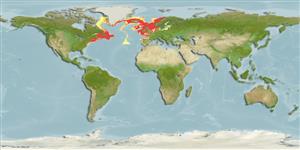Preferred temperature (Ref.
115969): 0.6 - 11.4, mean 7 (based on 1302 cells).
Phylogenetic diversity index (Ref.
82804): PD
50 = 0.6250 [Uniqueness, from 0.5 = low to 2.0 = high].
Bayesian length-weight: a=0.00457 (0.00365 - 0.00573), b=3.08 (3.01 - 3.15), in cm Total Length, based on LWR estimates for this species (Ref.
93245).
Trophic level (Ref.
69278): 3.2 ±0.2 se; based on diet studies.
Resilienza (Ref.
120179): Medio, tempo minimo di raddoppiamento della popolazione 1.4 - 4.4 anni (K=0.15-0.2; tmax=25).
Prior r = 0.49, 95% CL = 0.32 - 0.73, Based on 1 stock assessment.
Fishing Vulnerability (Ref.
59153): High to very high vulnerability (68 of 100).
Climate Vulnerability (Ref.
125649): Low to moderate vulnerability (34 of 100).
